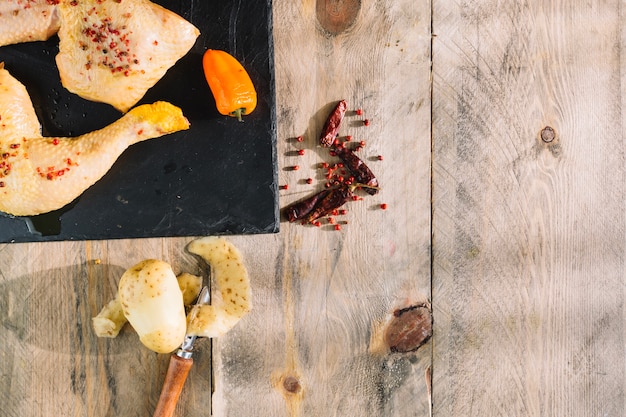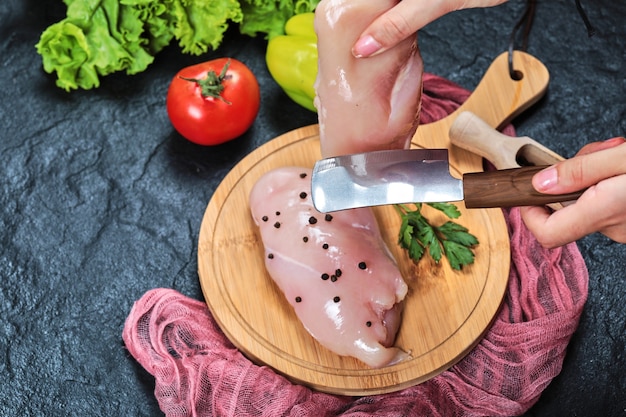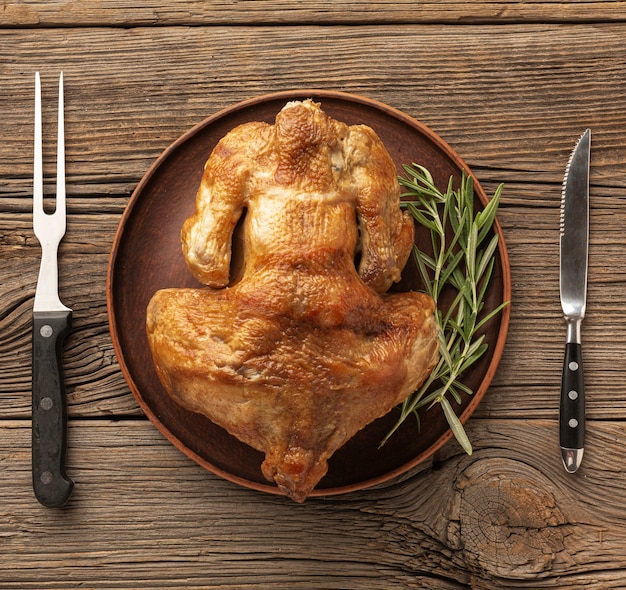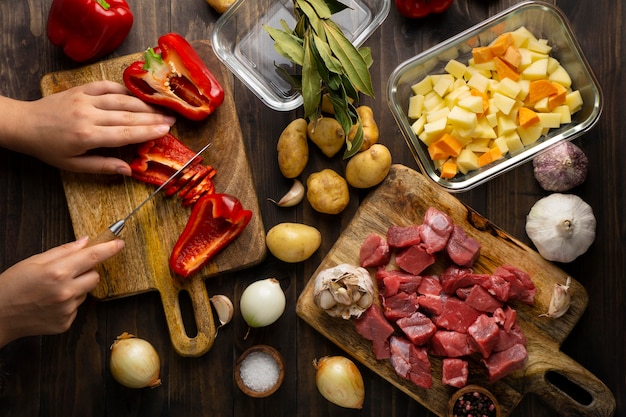Ah, the humble turkey breast. A culinary staple, a Thanksgiving hero, and a delicious source of protein for any occasion. But, let's be honest, cooking a turkey breast on the bone can feel a bit like navigating a culinary minefield. Those pesky cooking times, the fear of dryness, and the pressure to deliver a perfectly roasted masterpiece – it's enough to make anyone sweat.
Don't worry, my friend. I'm here to guide you through this journey with a wealth of tips, tricks, and personal anecdotes I've accumulated over years of turkey-roasting adventures. So, grab a cuppa, settle in, and let's get cooking!
Part 1: Understanding the Basics

A. The Size Matters: Weight and Cooking Time
Let's start with the fundamentals. The key to a successful turkey breast is understanding the link between its size, weight, and the time it takes to cook. It's not just about throwing it in the oven and hoping for the best.
My go-to rule of thumb? Allow around 20-25 minutes per pound for a bone-in turkey breast. This is where a good kitchen scale comes in handy. Weigh your bird, multiply by those magic minutes, and you'll have a decent starting point for your cooking time. Remember, we're aiming for a juicy, tender breast, not a dry, overcooked mess!
B. Temperature is King: Oven and Internal
Now, let's talk temperature, because it plays a crucial role in achieving that perfect roast. I always preheat my oven to 325°F (160°C). This ensures even heat distribution and prevents any hot spots that can lead to uneven cooking.
And what about the internal temperature? That's where a good meat thermometer comes in, my friend. It's a vital tool for any serious cook, and an absolute must when dealing with poultry. You want to aim for an internal temperature of 165°F (74°C) in the thickest part of the breast. Don't just rely on guessing, use that thermometer! It's your ticket to a safe and perfectly cooked turkey breast.
C. The Art of Resting: Patience is a Virtue
Here's a tip that's often overlooked: let your turkey breast rest for about 15-20 minutes after it's cooked. Why? Because resting allows the juices to redistribute throughout the breast, resulting in a juicier, more flavorful bird. It's a small step that makes a big difference in the final outcome. So, don't be tempted to carve it up immediately. Let it rest, and you'll be rewarded with a truly magnificent roast.
Part 2: turkey breast cooking Time Chart

So, you know the basics. Now, let's get a little more specific with a handy cooking time chart. This will give you a good starting point for different weights:
| Weight (pounds) | Cooking Time (minutes) |
|---|---|
| 4-5 pounds | 100-125 |
| 6-7 pounds | 150-175 |
| 8-9 pounds | 200-225 |
| 10-11 pounds | 250-275 |
| 12-13 pounds | 300-325 |
Now, I know what you're thinking: "What about those odd-shaped, non-standard turkey breasts?" Don't fret, we'll delve into those in the next section. This chart is a fantastic guideline, but remember, it's always best to check for doneness with a meat thermometer.
Part 3: Estimating Cooking Time for Those Unconventional Breasts

Okay, so you've got a turkey breast that's a little more unique than the standard fare. Maybe it's a bit thicker, or it has a wonky shape. How do you estimate the cooking time?
A. Oven Size: It Matters More Than You Think
One factor that often gets overlooked is the size of your oven. A smaller oven might require a bit extra cooking time because the heat isn't distributed as evenly. On the other hand, a larger oven might cook the turkey a bit faster, thanks to its greater capacity. Take this into account when estimating your cooking time.
B. Shape and Thickness: Those Extra Curves
As you might imagine, the shape and thickness of your turkey breast also play a role. If it's particularly thick, you'll need to add a little extra cooking time to ensure it cooks through. I've learned the hard way that rushing it could lead to an undercooked center. If it's a bit thinner, you might be able to shave a few minutes off the cooking time.
C. Meat Thermometer: Your Cooking BFF
Seriously, it's your best friend. I can't stress enough how important a meat thermometer is, especially for those more unconventional breasts. It's the only way to know for sure that your turkey breast is cooked to perfection, no matter its shape or size. Stick it into the thickest part of the breast, avoiding the bone, and wait for that magical 165°F (74°C).
Part 4: Cooking Methods: Roast, Grill, or Slow Cook?
There's no one-size-fits-all approach when it comes to cooking your turkey breast. Let's explore the different methods you can use:
A. Roasting: The Classic Choice
Roasting is the tried-and-true method for cooking a turkey breast. It's simple, reliable, and delivers a delicious result. Preheat your oven to 325°F (160°C), place your turkey breast in a roasting pan, and cook for the recommended time.
Here's my little secret: I love to add a few tablespoons of butter and some herbs like rosemary, thyme, and sage to the pan. It adds a burst of flavor and keeps the breast moist. You can also baste the turkey with pan juices every 30 minutes or so for an extra boost of flavor and moisture.
B. Grilling: For the Outdoor Enthusiast
If you're a grilling aficionado, you can definitely cook a turkey breast on the grill. Just make sure you have a large enough grill to accommodate the bird. I recommend using indirect heat, which means placing the turkey breast away from the direct heat source. Cook for around 15-20 minutes per pound, and always use a meat thermometer to check for doneness.
C. slow cooking: For the Ultimate Tenderness
Slow cooking is a wonderful option for a truly tender turkey breast. Place it in your slow cooker, cover it with some liquid (like broth or stock), and cook on low for 6-8 hours or on high for 3-4 hours. This method results in a wonderfully tender and juicy turkey breast. It's perfect for a busy day, and you can even let it cook while you're at work or running errands.
Part 5: Tips for a Juicy Turkey Breast: Maximizing Moisture
We all know that dry turkey is a culinary crime. Here are a few tips to ensure your turkey breast is incredibly moist:
A. Brining: The Secret Weapon
Brining is a game-changer for those seeking a juicy turkey breast. It involves soaking the turkey in a salt solution for a few hours, which helps to retain moisture and make the meat incredibly tender. You can find a plethora of brining recipes online, so get creative! I love adding herbs and spices to my brine, like lemon zest, peppercorns, and bay leaves.
B. Basting: A Splash of Flavor
Basting, as we mentioned before, is another fantastic way to keep your turkey breast moist and flavorful. Spoon the pan juices over the turkey every 30 minutes or so while it's cooking. It adds flavor and helps prevent the breast from drying out.
C. Meat Thermometer: Your Moisture Guardian
As always, using a meat thermometer is crucial for ensuring your turkey breast is cooked through without being overcooked. Overcooking is a common cause of dryness, so keep a close eye on that internal temperature.
Part 6: Flavoring Your Turkey Breast: Turning up the Taste
Now, let's talk about flavor! A turkey breast is a blank canvas for culinary creativity. There are endless possibilities when it comes to seasoning, stuffing, and glazes.
A. Herbs and Spices: A Symphony of Aromas
I love using a blend of herbs and spices to enhance the turkey's natural flavor. My go-to blend includes rosemary, thyme, sage, garlic powder, onion powder, and paprika. But feel free to experiment with your favorite combinations. I've also used citrus zest, a splash of white wine, or a drizzle of honey for added sweetness.
B. Stuffing: A Delicious Secret
Stuffing your turkey breast is a great way to add depth and complexity to your dish. You can create a traditional bread-based stuffing with vegetables, herbs, and even sausage for extra flavor. Just make sure to pack it loosely so it cooks evenly.
C. Glazing: That Golden-Brown Perfection
For a beautiful golden-brown finish and an extra layer of flavor, try brushing your turkey breast with a simple glaze. I like to use a mixture of butter, honey, and a touch of soy sauce. Apply the glaze in the last 30 minutes of cooking, and it'll create a beautiful, crispy exterior.
Part 7: Serving and Storing Leftovers: Making the Most of Your Turkey Breast
Your turkey breast is finally cooked to perfection! Now, it's time to carve, serve, and enjoy the fruits of your labor.
A. Carving: A Sharp Knife is Key
Use a sharp carving knife to slice the turkey breast into thin pieces. You want to carve against the grain of the meat for the most tender slices.
B. Serving: Time to Feast!
Serve your beautifully roasted turkey breast hot with your favorite sides. Think mashed potatoes, gravy, stuffing, cranberry sauce, green beans, and roasted vegetables. Don't forget to have a few slices of sourdough bread for those delicious turkey sandwiches.
C. Storing Leftovers: Keep It Fresh
If you have any leftovers, store them in an airtight container in the refrigerator for up to 3 days. You can reheat them in the oven, microwave, or on the stovetop. turkey leftovers are great for sandwiches, salads, or soups. Get creative and find new ways to use those delicious leftovers!
Part 8: FAQs: Your Turkey Breast Questions Answered
Let's address some common questions about cooking turkey breast on the bone:
1. What's the best way to prevent a turkey breast from drying out?
Besides brining and basting, there are a couple of other things you can do. First, make sure you don't overcook the turkey breast. Use your meat thermometer and pull it out of the oven once it reaches 165°F (74°C). Second, consider using a roasting rack to elevate the turkey breast, allowing air to circulate around it and preventing it from sitting in its own juices.
2. Can I cook a turkey breast in a slow cooker?
Absolutely! Slow cooking is a great way to make a tender and juicy turkey breast. Just make sure to cover the breast with some liquid, like broth or stock, and cook it on low for 6-8 hours or on high for 3-4 hours.
3. How do I know when a turkey breast is done?
The best way to know when a turkey breast is done is to use a meat thermometer. Insert it into the thickest part of the breast (avoiding the bone) and make sure the temperature reaches 165°F (74°C). You can also check for doneness by pressing on the breast with your finger. If it feels firm and springs back, it's done.
4. What can I do with leftover turkey breast?
Leftover turkey breast is a culinary treasure! You can use it in sandwiches, salads, soups, or even casseroles. Get creative and have fun with it! My personal favorite? A turkey and cranberry sandwich on sourdough bread.
5. Can I freeze a turkey breast?
Yes, you can freeze a turkey breast for up to 2-3 months. Wrap it tightly in plastic wrap or aluminum foil, then place it in a freezer-safe bag. To thaw, place it in the refrigerator for 2-3 days. You can also thaw it in the microwave or by soaking it in cold water. Remember to cook the thawed turkey breast thoroughly before serving.
So, there you have it, my comprehensive guide to cooking a perfect turkey breast on the bone. Remember to use a meat thermometer, don't overcook it, and enjoy the process! Happy cooking!
Everyone is watching

Perfect Rice Every Time: The Ultimate Guide to Cooking Rice
Cooking TipsAs a self-proclaimed foodie, I've always been a bit obsessed with rice. It's the foundation of countless cuisi...

Ultimate Guide to Cooking the Perfect Thanksgiving Turkey
Cooking TipsThanksgiving. Just the word conjures up images of overflowing tables laden with delicious food, the scent of r...

The Ultimate Guide to Cooking Asparagus: Tips, Techniques, and Recipes
Cooking TipsAsparagus. The mere mention of this spring delicacy conjures up images of vibrant green spears, crisp and burs...

Can You Cook Spaghetti with Gasoline? (The Shocking Truth)
Cooking TipsWe've all seen those crazy internet trends. You know, the ones that make you wonder, "Did someone actually try...

Chorizo and Eggs Recipe: The Ultimate Guide
Cooking TipsRight, let’s talk about chorizo and eggs. You know, that classic Spanish dish that's always a winner. It's th...
